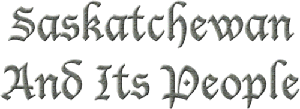PERSONAL KNOWLEDGE OF THE EARLY EUROPEAN IMMIGRANT.
THE HEBRIDEAN SETTLERS.
These good people were sent out from the Hebrides in 1889 by the
Imperial Government, some ten thousand pounds sterling having been
voted for the purpose. Previously Lady Gordon Cathcart had sent
out a large number to Killarney, Manitoba. A "Board" was established at
Winnipeg, which obtained its authority from another Board in London,
England. The local agent was Mr. George Borrodaile, and Nitchie Hill
did most of the locating in townships 25 and 26 ranges 1 and 2 west of the
second Principal Meridian, which townships are just north of Saltcoats
and covered what at that time was a rather bushy and sloughy bit of coun-
try.
The Manitoba and North Western Railway Land Department through
A. F. Eden, Land Commissioner, took an interest in these settlers and
arranged for me to assist in their being settled. Carloads of oxen and
cows, wagons, etc., were sent up and part of my work was to value the
cattle and "jewel" their ears for identification. The new-comers lived for
several weeks in box cars, tents, etc., near Saltcoats, till the outfits were
apportioned, land selected, and lumber shacks erected. As the settlers got
their cattle they tethered them on long ropes; and when they took them to
water, or essayed to hitch up their oxen they hauled at them as if they
were anchors or making sail, for they had been sailors and fishermen.
This was very amusing to a landsman.
The men did not take kindly to the land at first, as they had done little
else hut fish before, while the women cultivated the little "crofts" or farms,
and cured the fish. Their business, I was told, was to catch fish, and when
ashore they considered themselves practically off duty as it were. Only
a few could speak English, Gaelic being their native tongue', and their
music the bagpipes. They ordered their oxen to starboard or to port and
called the land the shore. They were a pretty hard lot to control as the
Imperial authorities had discovered, and the habits of some of them left
something to be desired. The women were very hard working, but ratber
subdued. All were more or 1ess superstitious but devout Presbyterians.
There were of course exceptions but they were pretty much of a type.
They were anxious for school however, and the districts of Dunleath
and Tupper were erected, the buildings being also used as churches and
Sunday schools. I believe Sir Charles Tupper, the High Commissioner
in London had something to do with prevailing on the Imperial authori-
ties to send them out; hence one of the school districts was named in his
honor. As 1889 was a year of drought it was decided to grade the rail-
way from Saltcoats to Yorkton to give as many settlers as possible a
chance to earn money. This of course included the settlers of all descrip-
tions. It fell to my lot to carry out the plan and I had a sweet time of it.
It was alright with the old settlers, but the crofters were the limit. The
work on the grade was mostly done with oxen, and all was finished in six
weeks, before it froze up for the winter except some of the crofter jobs
for they practically mutinied and much of the work they should have
done had to stand over for the next summer. However they earned some
money which was divided equally among them.
The colony was very backward for some years, but as some of the
younger generation grew up they took homesteads farther north in a
very fine open country, and the old people generally speaking abandoned
their original holdings, which were under lien to the ImperIal Board in
London for the expenses of settlement and equipment, and moved up to
Bibliography follows:

